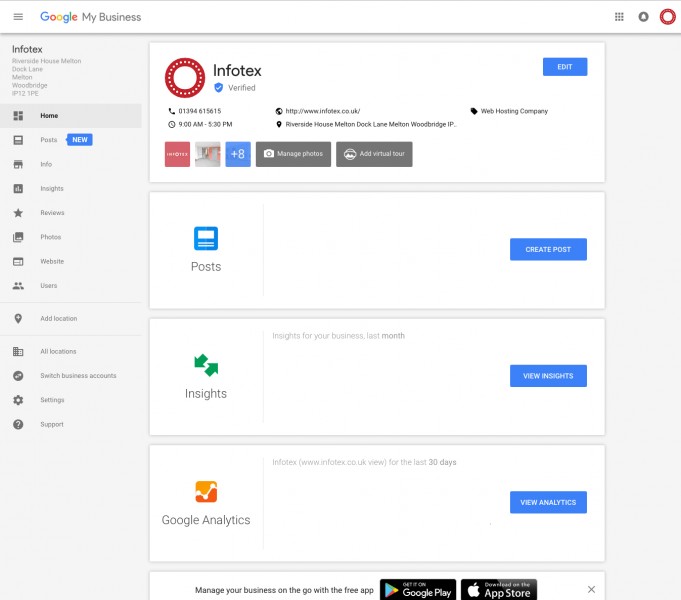

If you haven’t already got a Google My Business listing then what rock having you been living under!? It provides those searching for your business with all the important information they will need such as:
In addition to this, a Google My Business listing is essential to a website’s local SEO, especially those searching using local terms. Fully optimising your listing could help improve how your website ranks organically on Google for a whole array of search terms related to your business.
The best thing of all? It’s completely free!
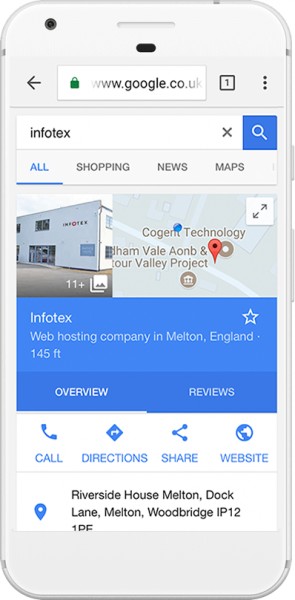
Posts is one of the latest features to be added and just another reason why your business should be taking full advantage of what a GMB listing could offer.
Recommended Factors to Optimise your Local Ranking on Google
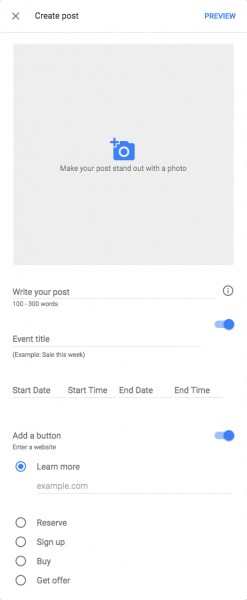
The Posts feature in Google My Business allows companies to post an image with short write-ups accompanied by “calls to action” below in the form of buttons. The variety of opportunities that this gives small businesses to promote their product/service are endless –
Those three examples are just the beginning in how you could use Posts to market your business directly onto the Google search results page. These posts would also expand the size of your listing, a huge bonus due to the hypercompetitive nature of the Google SERP.
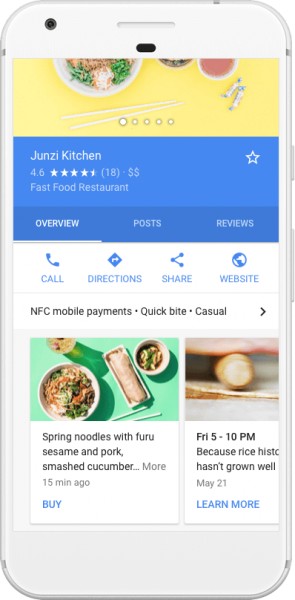
Once setup, there wouldn’t be any extra work involved in posting here if you are already using social media outlets such as Twitter/Facebook. This is the answer to the question “How can I promote my business on Google without spending loads of money?”
If you are interested in setting up a Google My Business (GMB) listing and utilising Google Posts then please get in touch with us and we’d be glad to guide you through the process. Our marketing department have a wealth of experience helping businesses improve their online presence through Google My Business.
I already had an account with around 29 followers (pretty meagre). But if you haven’t you need to download the app onto your phone and set up an account. To aid being found I recommend both your username (known as a handle with the @ sign) and your name having reference to what you do in it. For example I set my name as Abstract Landscape Artist. You are then more likely to come up in a search of your your specialism.
Write your biography wisely and link to a relevant page on your website in the URL (web address) field. This is the only small area you have to promote what you do and direct people away from Instagram.
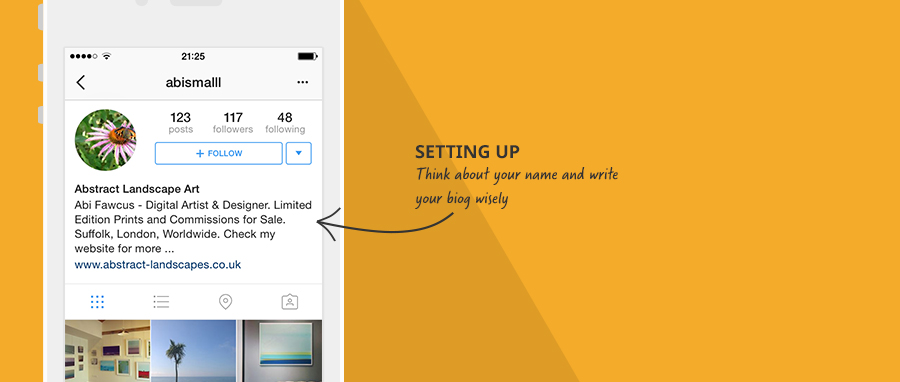
Then choose the amount of times you think you can feasibly post each day and get started. I went with one but three is optimal.
Your pictures need to be good. Look around, there is a very ‘glossy’ magazine feel to Instagram. It is also starting to be more common to see the animated gifs or video loop images offered by new smart phones.
Friendly and kind. This is not twitter.
People are more reserved about who they follow than on other social platforms, they are much more likely to ‘like’ than give you a full resounding follow.
Etiquette seems to suggest you should have more followers than be following.
Make sure you use the hashtag (#) in each post.
The only way for you to reach those outside your own following is including a hashtag they may be interested in. Think clearly about what subjects your audience would look at and make sure that your hashtag includes:
Six hash tags is about right. if you want to set your hashtags away from your post text, you will often see people use ‘–’
For example;
This is the text for my insta-post
—
#hashtags #subject #location #etc
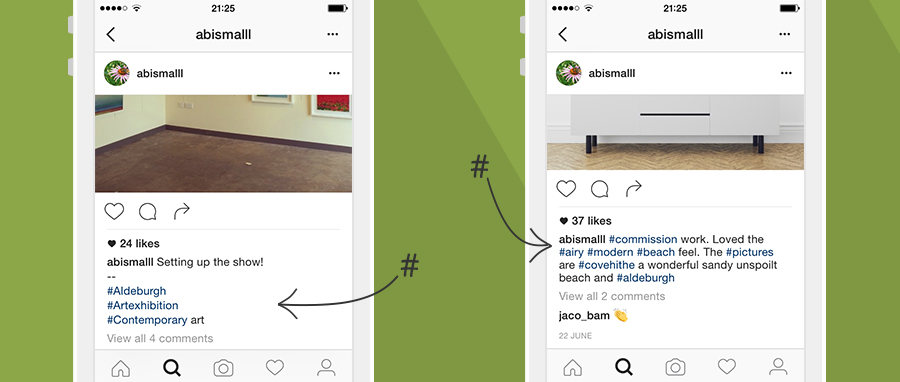
You can indeed increase your following by good old fashioned hard work.
Quite excited I surfed around on Instagram looking at people trending on hashtags similar to the ones I was using. I commented on their pictures and in return got some nice comments back, a few likes and some thank yous but not really any follows.
I checked out the ‘settings’ tab on my instagram and under ‘Find & Invite Friends’ trawled my contacts stalking anyone I had ever known – and followed – with not that much response.
Then I looked at ‘Suggested Users’ and, being a little more sensitive here, I liked or commented on their images and then followed. The response was good, better than my real friends! I got quite a few follows back and increasing likes.
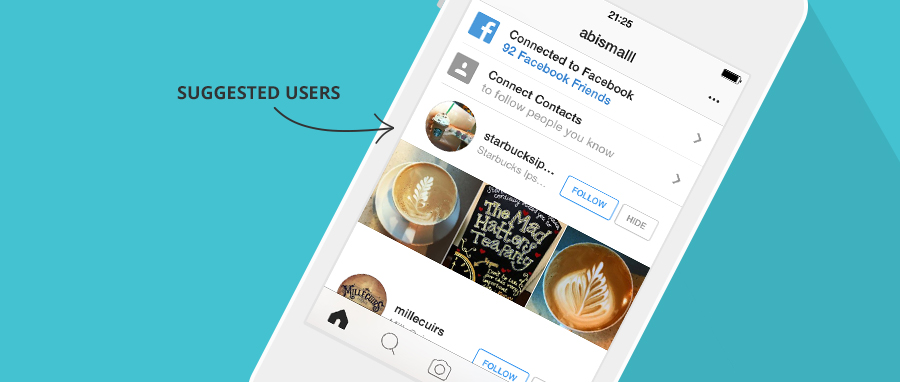
So I now knew that if I made the effort to look, comment and then follow I was more likely to get people taking the time to look at me and follow, but more often it started in lots of likes. I found if I checked the ‘grammers’ that had left likes (but no follow) commented or posted on their feed, then followed them I was getting a higher rate of follow returns.
I also noticed that my activity and engagement was snowballing I was reaching wider and growing likes, comments and follows.
Next I checked how my time of day was affecting numbers.
Currently I was posting at 9pm so I tried at 7am and 12pm. The numbers were considerable; midday doubling and early morning tripling so I moved my daily post to 7am.
Small trick – I also learned to cull dead followees, those I was following who were not attentive to my path to greatness.
I did some real world research.
I went about my day asking anyone I could what they thought of Instagram and how it worked for them – there are definitely industries that thrive on Instagram and I found many people and small businesses for whom Instagram is a brilliant marketing tool bringing them many sales. These industries are generally fashion, food, lifestyle and outdoor adventure.
So what if you aren’t in one of those industries?
In one word….Keywords.
#Hashtags are key but tagging just for ‘your’ industry is not a way to approach a wider audience so I started #ing the industries that worked. Adding #interiors #interiordesign #womensfitness #wheretonext and apparently blueberries and donuts do wonders for likes too, but no, even I had a limit to how low I would stoop. That said using the hashtags from popular industries definately increased likes which in turn after I had engaged, cultivated follows.
You can see a few popular hashtags in this article; www.postplanner.com/best-instagram-hashtags
So numbers were growing, this was great wasn’t it?
Now I just focused on those liking my posts. I checked them out, liked, commented and followed. This showing of interest in them over just following increased my follows, but as this grew as did my time responding and although I discovered new, nice and interesting stuff it was taking up my time which should have been spent doing actual work.
‘I wasn’t doing this out of enjoyment but for the benefit of my business’
Unlike pinterest where I surf just to find ephemera and inspiration I wasn’t doing this out of enjoyment but for the benefit of my business, this is very different from using a social platform for social or personal purposes. So was the return on investment enough for the time (and therefore money) I was spending?
I was pleased, I had more than tripled my following and it was easy to see that this was a snowballing effect. As I continued posting and tagging once a day, my numbers were growing at a much quicker rate than the virtually ‘zero’ movement before this experiment.
There is no doubt that Instagram, and all the other social media platforms help build very successful businesses, however choose wisely, test, decide, create a strategy and importantly – stick to it. Even those that have millions of followers all say it is hard work, and just posting with the odd hashtag and sitting back and waiting will not bring you riches.
With 300 million active daily users on instagram yes that means you have a far reaching pool but it also means you have a big ocean to navigate through, with your lone voice needing to rise above other – dare I say – natives, and many millions of those are of course not interested in your line of business.
Yes and no. Social media is not a magic wand but if you choose your social media platform carefully, have a strategy and a campaign – and stick to it – it is likely to work. But sporadic posting across random platforms is less likely to help your business and more likely waste you time.
Stats on conversion rates seem to vary considerably but most say social platforms are around or below 1% with newsletters being much higher than that so finding the right platform and finding the right person (not everyone has the knack) is an expense that needs to be factored in. In the end, social marketing is no different from traditional marketing, find what suites you and stick to it, routinely making sure the return is worth the outlay.
You can find a large selection of stats here if you want to know more: www.expandedramblings.com/
And finally, if any of these alarm bells have rung for you and finding the right marketing avenue to turn down is on your mind why not give us a call.
All our advice is born out of hands on experience and delivered with unbiased recommendation.
Statistics show that Instagram has overtaken Twitter in active users but Twitter still has far more posts shared each day (500 million tweets v. 80 million instagram images) but what do these statistics mean for me?
Both have a very similar demographic but the main difference is that Twitter is a great platform for sharing content, users can automatically post or share from other social platforms or from a blog, therefore quickly getting content into Twitter to encourage users back to your website or main marketing platform.
Instagram on the other hand is very much ‘in app’ with the user’s complete attention as they are unable to click to go to blogs, videos or outside links. Marketing campaigns must centralise around engaging audiences completely within that platform, not spring boarding them out (of course there is always ways around this) but it is quite a different approach to marketing that needs to be thought about.
Instagram is tapping into a community of very visual consumers, image quality is everything and a great place to build a brand and loyal followers. Whereas Twitter is good for sharing content and interacting quickly with customers, so much so that many large online organisations use Twitter to deal with ongoing support issues.
One thing is for sure that the digital landscape doesn’t stand still. Do you remember Myspace and Friends Reunited? The rise of Facebook that was then threatened by Twitter and now Instagram. So it is a pretty safe bet that the next big thing will come along and I have always been under the instinct that early adopters to a platform are actually the ones that reap the benefit, they take a risk, start when the pool is small and get rewarded.
So we have Snapchat making waves with businesses already looking to market here to a very young audience, there is also Vine, and many more. Two new ‘Instagram’ style platforms to watch still in their infancy are Ello and Hyper. Both follow a similar strategy to Instagram but Ello’s manifesto is no advertising not ever. And Hyper with a voting system and anonymous ‘secret’ style posting which could be quite interesting for brands, has the backing of Vine.
Ello’s no advertising manifesto is quite interesting as if using social media purely for selling, then advertising is a quicker way to get in front of your audience and so an avenue to think about. And if it is just about selling then thinking which channel of marketing will actually get the best return on investment is incredibly important, and that may or may not be as an active social media participant.
But mainstream social media platforms are not the only form of social marketing. Currently for me my best return on investment is my newsletter – so efforts should be put to getting more subscribers here.
Also looking at industry specific media platforms is another option. These exist for most industries, and as an example if you are a gallery, photographer, artist or interior designer there is SaatchArt or Houzz. Different audiences but they are still social media, and some of the algorithm’s within these platforms don’t require you to be quite so virulent to get noticed which is another factor when looking for the right marketing balance.
These niche platforms on which you can create a following from an audience actively looking for your type of product or service, although there may be less users and less posts than the big 3, they are much more qualified leads.
The thought is not, should I be using Twitter or Instagram, Facebook or Linkedin, the questions is what is my marketing strategy and which platform is going to best suit my business, audience, time allowance and budget. These platforms don’t work for everyone and is spreading yourself thin really going to be more beneficial than a contained effort?
There are, and always have been small factions of people that do things differently, but with the connection of social media their voice can gain traction very quickly. This cool hunting means a wave movement of users across platforms scouted out by those hipster explorers and pioneers, followed by the influencers, then mainstream and marketing bringing up the rear.
This pattern won’t stop it has been going on in a social context throughout humanity but our global connection has made it a much faster and more fickle movement. Standing still as a business has never been harder with such a strong forward current as technology expands and globality contracts.
So don’t just jump on the latest bandwagon as it won’t last but instead use that traditional approach of ‘which type of marketing actually works for us’. Time is money and all marketing avenues should be considered. Social media, although very much a tool in our marketing toolkit is not the free, magical, marketing machine we have perhaps been lead to believe. Research, testing and a firm strategy, with routine and continuity will stand you in good stead – and you never know you may even become an influencer not a follower.
I spent a week ankle deep in Instagram and a few of the other visual social media platforms to give some insider insight in my article coming out next week. But if this is already on your mind and you can’t wait until next month why not give us a call and pick our brains in relation to your business online.
An app is any form of software application, most notably thought of as the tools we download on our phones and tablets to chat to friends, make bookings or play games. But it can also be the programs we use on our computers or IOT devices.
Previously an app has been something you download from an app store – Window or Apple app store, Google play (android) – or a software reseller. You need to download the right type of app for your device and make sure it is compatible with your version of software but once installed you are in its own little microcosm; with notifications, offline processing, access to the inbuilt camera, storage – it’s more secure and less likely to get hacked – and incredibly fast.
Until now mobile websites were unable to compete on this level, as they are not equipped to make use of the built in processes of a handheld device.
But it wasn’t all in Native apps’ favour. Knowing what you want and going to find an app in an app store is one thing but discovery through search engines is a powerful way to gain more visitors. Add to that the fact that a user must download, install and setup the app before they are even allowed through the door – which is known on the web as friction – it’s pretty damaging to the conversion rate of the visitors that do come.
In an attempt to combat this effect, Google decided to try and align the best elements of both web pages and applications to create Progressive Web Apps (PWA). This technology loads quickly, even on flaky networks, sends relevant push notifications, has an icon on the home screen and loads as a full screen experience.
PWA’s are still searchable on search engines but make use of the inbuilt processor. It lowers friction by allowing users to immediately get a feel for the content then gently suggesting saving the app to their home screen. It runs a ‘one size fit’s all’ when it comes to compatibility with OS and devices and does not rely on requiring each user to activate updates to their install.
One of the earliest examples of progressive web apps being adopted is Flipkart – India’s answer to Amazon and one of the country’s largest online shops – releasing Flipkart Lite. This version saw 3x more visits on a mobile than the old site and returning visits go up by 40%.
Service Workers
All of this is possible because of the development of Service Workers, which formulate the building blocks of web apps and hugely improve load time. They run as scripts working in the background of the browser or web page, opening doors to features which don’t need a web page or user interaction.
The offline capabilities of the service worker are already apparent with the push notifications you receive from various apps. However, the future lies in their ability to background cache/sync and in geofencing – a location-based mobile service that lets marketers send messages to your smartphone when you enter a defined geographic area.
Response, Animation, Idle & Load (RAIL)
It is clear that we are living in an instantaneous society where an ever-increasing speed with our technology is demanded from the public. This is where RAIL comes in. RAIL stands for Response, Animation, Idle and Load and represents the four key stages involved in the actions for your website/app. The optimisation of each of these distinct areas will reduce user frustration and retain viewers – 40% of audiences are lost if a page takes 7 seconds to load, remember that goldfish from last month’s AMP article?
Unfortunately no – well not yet…Progressive Web Apps are only available on Android devices and even then, service workers are only supported on Chrome and Opera browsers so their accessibility is hugely limited (although it is suggested that iOS devices may be supporting this technology as early as late 2016).
This is why our job as digital designers and system developers is to listen and learn from all that is out there and make sure that our work is not dependent on a new product from an internet giant, but that we heed the underlying message that users are sending out which culminates in these type of responses – two of which I have talked about here. Making sure that we offer the correct and considered advice to our clients and that our websites and applications work and continue to work optimally and inclusively for the needs of your business.
This new form of web app can be taken advantage of by most industries but one we feel is of special interest is estate agency. Many of our clients have talked about the benefits of an app, but the budget and friction of installation has generally made it prohibitive when competing against the property portals. The benefits of a web app bring the barriers of entry way down making it inviting for both estate agent and applicant. An estate agency could expect an increase in returning visitors and improved site stickiness if customers can be prompted to save the app to their mobile or tablet home screen and applicants get to just save and browse the agents they know are right for them not trawl through pages of unsuitable properties on the portals each time. Could this even be the real start of the decline in power of the portals?
A key Google characteristic in my mind is the long play. They do something because they believe in it, and keep on doing it for as long as it takes for it to yield.
This idealism has anchors in the real world. The pragmatic recognition that revenues come high on the list of priorities saw to it that Google Adwords got plenty of attention in the early years, since when the company has been able to power its way through numerous adventures, perhaps most notable of late being “driverless electric cars”.
Of course, key to Adwords success was the early dominance of the “free” Internet search engine space – which required focus and brilliance – so that the advertising platform could dominate “paid search” in equal measure.
So here is this leviathan, powered by incredible advertising revenues worldwide to which Infotex has paid its dues in a small way over the years. When I overheard Dan, Tim and Ollie talking about “Google Elevator”, I thought “Well, they are making cars, why not elevators?”
So imagine my surprise and delight when we were invited as a (let’s face it) rather small “Google Partner” to join their Google Elevator Partner Business Owners’ Coaching Programme.
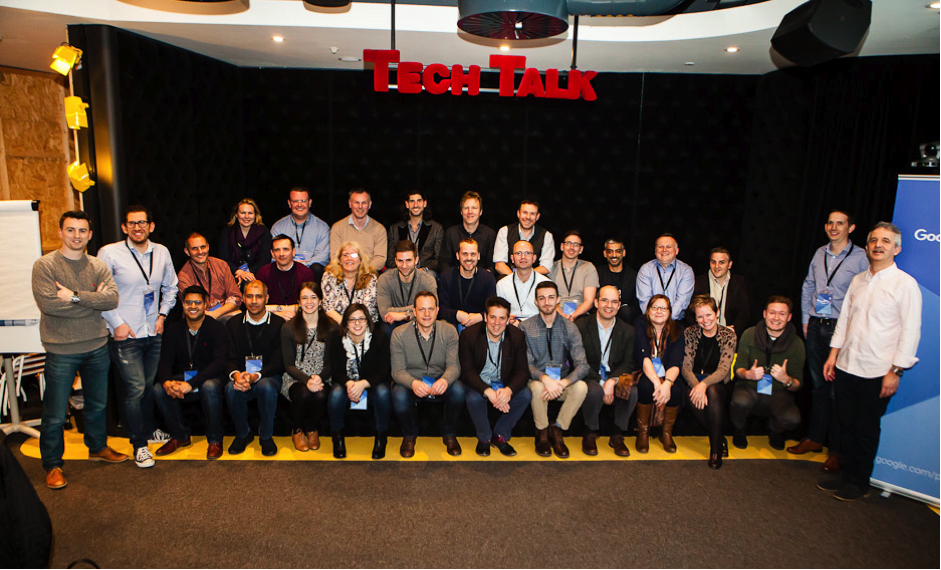
Google have recognised that there are thousands of hard working and intelligent people out there running digital marketing agencies, which when combined generate billions in ad revenues. Often the work of a digital agency is challenging, commercially risky and just plain old hard going. To support this community and help us to do better, a handful of us were selected to join their Partner Elevator programme – these are the agencies in whom Google can see potential, and to whom Google is pleased to give back.
This programme bears all the hallmarks of other Google activity. We have been provided with access to some of the best coaching and mentoring services around. All in Google’s London HQ with the legendary supplies of food and cupcakes. Headed up by Robert Craven of The Director’s Centre, a team of his consultants and Google staff have provided us with workshops, books and one-to-one coaching sessions to use in any way we wish for the improvement of our businesses. Very Google.
For me this has come at an ideal time. Infotex is 12 years in the making, and I am 53! We have a great company that has already covered a lot of miles and has real strengths. The time is right for us to look to the future and crystalise our vision for 2020 and beyond.
Robert and his team are inspiration combined with pragmatism – just as you would expect with all things Google. Here at Infotex we look forward to sharing insights over the coming months and how this experience will help you our customer.
The golden arches in any country gives me a craving for chocolate milkshake, a small apple with a bite taken out of it implies luxury technology and a mulberry tree makes me want to sell my husband just to get my hands on a leather bag!
The past couple of years have seen a number of brands alter their logo and 2015 saw the Infotex logo evolve and develop (more on this from our Design Director Abi Fawcus next month). But why did these companies change their already well-known brand symbol?:
1. TO ADAPT TO A CHANGING MARKET:
This year we saw the Google logo had its biggest redesign since 1999. The change was based upon how people react to Google across “many different platforms, apps and devices.”1 The typeface of the new logo is ‘product sans’ which combines “the mathematical purity of geometric forms with the childlike simplicity of schoolbook letter printing”. The renowned four colour is seen across the brand even featuring in the microphone design when using voice controls on your mobile.


Thetrainline.com has also adapted to the mobile market by changing their name to simply Trainline. They launched a new mobile app to illustrate their new brand concept of ‘Smarter Journeys’, with the CEO Clare Gilmartin stating that their “mission is to help people travel smarter, and by using their phones they can enjoy the advantages of saving money by buying in advance and ensuring they have real time travel updates during their journey.”2 The #IAmTrain campaign was also launched to promote the change with a heavy emphasis on using social media to promote the new mobile friendly brand.

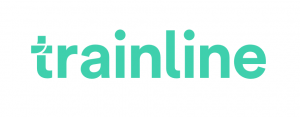
2. IN RESPONSE TO A MAJOR CHANGE IN THE COMPANY:
Pizzahut has recently redesigned their logo in response the their biggest menu change in years. Dubbed as the ‘Flavour of Now’ this new menu is seen as a response to their recent stagnation in the market and this logo change is used to help the transition. The Vice President of Marketing commented that “Any good flavorful pizza starts with a sauce swirl”3 which is what inspired the red swirl on the edge of the logo.
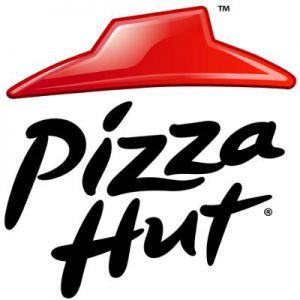
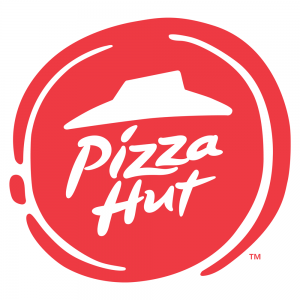
3. TO PROMOTE A NEW BRAND IDENTITY:
Airbnb completely changed their brand positioning in 2014 by promoting the sense that their customers can ‘belong’ in any of the properties rented through their website. They introduced their “Bélo” logo – “It’s an iconic mark for our windows, our doors, and our shared values. It’s a symbol that, like us, can belong wherever it happens to be”4
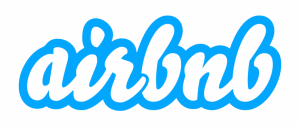
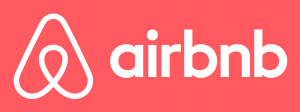
4. A BAD RESPONSE TO A LOGO DESIGN?
American restaurant giant IHOP (International House of Pancakes) changed their logo for the first time in decades this year. They have simplified the logo but the most major change is the red line below IHOP from a downward to an upward curve. According to the company’s Vice President of Marketing, the old logo “appeared as a person’s frown.”5 Instead he believes that the new and more positive logo will be more attractive to customers and “make them smile.”

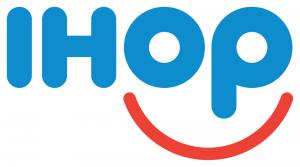
5. FOR THE SAKE OF CHANGE?
Facebook have made very slight alterations to their logo using a custom typeface to “modernise the logo to make it feel more friendly and approachable”6 (Josh Higgins, Facebook’s creative director). The most noticeable change is the “a” which is fuller and rounder.


1 Evolving the Google Identity
2. thetrainline.com Rebrands itself to Trainline
3 Inside the Pizza Hut’s Saucy Rebranding
5 IHOP Changed its Logo, says the old one looked like a frown
6. Facebook unveils new logo in stunning change for fans of the letter A
DOMAIN BREAKDOWN
There are two parts that make up a domain name, the first bit (not its technical name) and the domain extension – the dot com or dot co dot uk – at the end.
There are a massive range of domain extensions available, suitable for virtually every company type known to man. The most common and familiar extensions being .com and .net, through to specific country extensions (also known as country code top level domains – ccTLDs) such as co.uk, and .de, then to the more generic .info and .biz.
Google.com was supposed to be googol.com – a misspelling by a graduate student while checking domain availability was to blame
FORGET DOT COM, GO DOT NINJA!
As there are only a finite amount of .com or .co.uk domain names it is becoming harder and harder for new companies trying to find a suitable domain name. However, there has recently been over 1,400 new extensions released for pre-order opening up a Pandora’s box of possibilities.
These extensions include .shop, .wedding, .hotel and even .ninja! The aim of these new extensions is to more accurately describe your business (though we’re not sure how this works with .ninja…) and vastly grow the range of domains available.
Some other domain extensions that are soon coming available:
It remains to be seen whether all of these new domains will prove to be popular, or go the same way as .info or the distrusted .biz. Registration on some domains would suggest a high uptake. .Berlin received 46,000 registrations within its first month.
For a list of all new GTLD domains click here
The most expensive domain ever purchased was VacationRentals.com – for $35 million in 2007.
The new owner confessed to paying so much just to stop Expedia from purchasing it.
ALL CHANGE FOR .UK
Nominet, the company who oversee .co.uk domain names, have recently announced the release of the shorter .uk extensions. This is happening in the summer of 2014, and brings the UK in line with other large ccTLDs, such as France’s .fr or Germany’s .de.
Existing owners of a .co.uk or org.uk will be offered the .uk equivalent of their current address, with five years to decide whether they want it. Where competition exists (with one company owning example.co.uk and another owning example.org.uk) the .uk domain will be offered to the .co.uk registrant.
DOT BRAND?
In 2012 a registration process was opened to allow brands to begin to register their own extensions. The $185,000 registration fee would deter all but the largest brands, but it may not be long before you see .coke, .heinz or .nike in use.
The most popular country code extension is .tk – the small South Pacific island of Tokelau. The .tk is so popular due to their unique business model of being free.
QUICK TIPS FOR SELECTING A DOMAIN
The first domain registered was symbolics.com in 1985, for the Symbolics Computer Corporation
SHORT URLS
Short URLs (Uniform Resource Locator – this is the full address of a page, not just the domain name) are links that take a long web address and make it shorter. They are popular on social media sites as they make links much more shareable, especially for long addresses.
For example http://bit.ly/LjnWMf redirects to this page
There are various free URL shortening services, such as bitly.com and goo.gl, although it’s increasingly popular to register a short version of your own domain for social sharing. Amazon use amzn.to, the New York Times uses nyti.ms, and the already short BBC.co.uk uses the even shorter bbc.in on Twitter.
If you operate a lot on social media then a small investment in a short version of your domain name can further help with brand building. Ideally we’d like infot.ex, but the .ex extension doesn’t exist. Yet.
DOMAIN VALIDATION
Starting from 1st January 2014, ICANN (they oversee top level domains) are introducing a new process that requires domain owners to validate their contact details via the email address held against their domain. When a domain name is registered, transferred or due to renew domain owners will receive an email asking you to validate the email address. Failure to do so within 15 days will mean the suspension of the domain name, until it has been validated. Validation is simply clicking a link, you should not be asked to enter a username and password or any other details.
LIST OF NEW GENERIC TOP-LEVEL DOMAINS (GTLD)
Please note that not all extensions below will be available for public registration. If you’d like to check availability and release dates of any domain name then please get in touch.
Discover how our team can help you on your journey.
Talk to us today